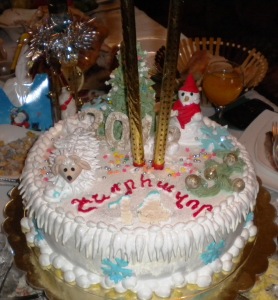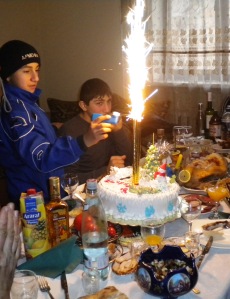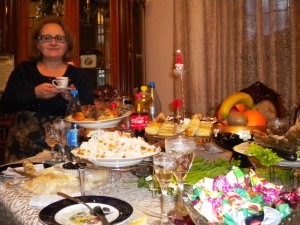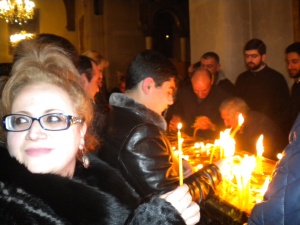The days following Nor Tari, or New Year, are for visiting family and friends. In the U.S. we do this in a day or two, but the Armenian tradition lasts two weeks – as does the food, remaining on the table from New Year’s Eve, less what visitors have eaten. It’s a pride of Armenian women to lay a table made beautiful by displays of abundant meat and other foods meticulously arranged on gold painted plates according to type, size and color along with mountainous fruit bowls and pastry platters.
We like a nice spread in America, too, but in Armenia the importance of how your dinner table looks or how you look is carried to noteworthy heights. These appearances define a woman’s value. They also define the stability and stature of the family and the man’s ability to provide for and protect his tribe. How many and which visitors come to sample the feast is also a measure of community standing.
Over the days, the volume gradually diminishes and new foods such as dolma and blinchik or “khorrovats” (barbequed beef and pork) are added to the ham shank, whole fish and plates of sliced fat, cow tongue and pastrami still lying quite dead on the table, though coated in salt. For an American, accustomed to overly refrigerated or at least covered leftovers, the dust collecting meats, hardening salads and flaking pastries are distressing. I stuck to the fresh and dried fruits and anything newly made. After a few days even these foods become suspicious as kitchens have been filled with bowls of meat thawing and then left sitting on the counter awaiting preparation. I don’t know much of this is ancient tradition and how much is a reflection of post-Soviet times of darkness, cold and hunger. It seems to be a reaction to survival mode and the abundance, represented by the dinner tableau, is evidence of its passing.
But – I digress! It’s the visits with family and friends that make this period special. In Ijevan, guests came to our house and we visited a neighbor family and my host Anahit’s parents and brother’s family before I left for Aygezard to visit the host family I lived with during Peace Corps training.
 I became convinced that Anahit’s family is the most loving in Armenia, given the expressions of caring I witnessed, especially for the children. Spending a day with such a broad mixture of family relations as hers was lovely.
I became convinced that Anahit’s family is the most loving in Armenia, given the expressions of caring I witnessed, especially for the children. Spending a day with such a broad mixture of family relations as hers was lovely.
My Aygezard family is similar in size and intensity, though in both families there are members now living in Russia for economic reasons. It seems family members generally stay with or near each other in case of needing to consolidate quickly to help each other. I’ve even felt an uneasy attachment to me of my village family with its over protection and insistence on knowing my whereabouts at all times. I appreciate their concern though it sometimes edges into an obsessive need for me to stay close in the family’s relational web. And having an American friend also seems status preserving.
Unlike in the U.S., the family is the most valuable network in Armenia and is the center of all life including business and commerce. On a moment’s notice that a family member needs help, teachers leave classrooms, shopkeepers close up shop and workers head home. There is no question about their absence.
The family is what has made Armenians survive for so long and through such adversity. Theirs is still an almost tribal society with an indifference towards those outside the family that verges on rudeness even to fellow Armenians. From what I’m reading, oppression by other nation states and Armenia’s isolation between enemies has led to this degree of familial protection as well as reliance on agriculture and the importance of food. Water is still often inaccessible and energy production is slight compared to need.
Armenians also don’t socialize much outside of family and very close friends. Other than in Yerevan, the capital, there’s no central source of community gathering or entertainment. A town might have a café, or it might not. If it does, it’s often used only by men. Sometimes there are “children’s cafes” where women take their children and gather to talk. But there are no community centers. And in Soviet times, church attendance was discouraged. Most families now have a small shrine in their homes where they light candles. By day, Armenians work, seek work or are the idle unemployed. At night they join their families. Boys may hang on street corners. Girls go home.
In Soviet times, communist regimes hung heavily over families discouraged from open and free association among themselves. As a result, when communism collapsed and Armenia became an independent state, no civil society had developed. Civil society grows only in a free environment where individuals voluntarily associate and exchange ideas to find and develop common values. Armenians had no such experience.
 As a Peace Corps volunteer tasked with community development, I’m now learning how challenging it is to override the power of the isolated family in an isolated country in order to create this open market of free and critical thinking out of which individuals will collectively produce sustainable growth. I hope, through having youth gatherings, to encourage this non-family interaction to foster civil discourse, though without losing the value of family relations.
As a Peace Corps volunteer tasked with community development, I’m now learning how challenging it is to override the power of the isolated family in an isolated country in order to create this open market of free and critical thinking out of which individuals will collectively produce sustainable growth. I hope, through having youth gatherings, to encourage this non-family interaction to foster civil discourse, though without losing the value of family relations.
But for now, coming home from my holiday sojourn through village and city, the challenge is that Aygezard had no electricity when I left and that Ijevan has no water on my return. These are frequent occurrences. Sometimes it’s a mechanical problem and sometimes an economic one. No water is flowing. A huge concern is that the cows are thirsty. This wouldn’t happen in Soviet times, the adults say. Perhaps not. But a mature civil society didn’t happen either. I just hope that young Armenians are as thirsty for that as the cows are thirsty for water.
And, news flash … I just learned there was another skirmish near the Azerbaijan border, not terribly far from Ijevan. Up the road where I’m not authorized to travel. The Azeris crossed the border again to antagonize the Armenians. An Azeri was shot dead. But so was an 80 year old Armenian – a shepherd in his field. I think of how it would have felt to have my own aged father shot as he tended his vegetable garden. Disturbing. And so it begins — a new year.

In my experience, Armenians judge each other on appearance, so many families finance their Nor Tari table with credit, the way they would finance a wedding. Some families put the expensive meats out but these are not carved or offered to guests. Post Nor Tari, the bones are cleaned and the meat parcelled out and frozen for meals through the winter.
Many Shirak Marz villages have community centers with a large room for celebrations and events like birthday parties and first or last bell. Village residents reserve the space and bring their tables, chairs, place settings and foods for these events. After the 1988 earthquake, 3 villages I’ve visited had their destroyed “Culture House” rebuilt.
Hello Bobbie! And thanks for your comment and for reading the post. I really appreciate that. I am aware that Armenians prioritize appearance and I find it both interesting and disheartening as appearance is such a shallow measure of one’s value or one’s soul. That they go into debt is something I also know, and again find it disheartening. Not that Americans don’t go into debt for the same reasons, but I think that’s also a shame. Because Armenians have so little, this emphasis on appearances is understandable, but very sad.
I didn’t know that Shirak Marz villages have community centers and that’s a great discovery since community socializing seems to be at a low in general, or at least that’s what I’m reading. I’ll have to probe further to find out if that’s also the case in Ijevan in the Tavush Marz where I am. That would be fabulous as I’m trying to encourage youth gatherings. Thanks for the info!
JContinuing to be a fascinating read, Susan. And you tell your experience and that of the experience and history of the Armenians so well. Thanks for doing such a great job of helping us back here understand this culture. Your blog is just super!
Doesn’t sound like a good place for vegetarians, but wonderful traditions nonetheless! Thanks for educating us about this part of the world!
Yes, they do eat lots of meat and potatoes. But in summertime especially, there are lots of fruits and vegetables which are very fresh and not full of pesticides, which is great (although the water used for irrigation is questionable). The tomatoes are amazing. They do make plenty of salads and soups with vegetables, which they put up in jars for the winter, and everyone makes compote and jam with fruit and stores it too.
My host, Anahit, has a garden with fruit trees and she plants vegetables. I can’t wait until spring to help her with it. She’s also had many Peace Corps volunteers and there’s a small “volunteer garden” that will be my little playground come spring.